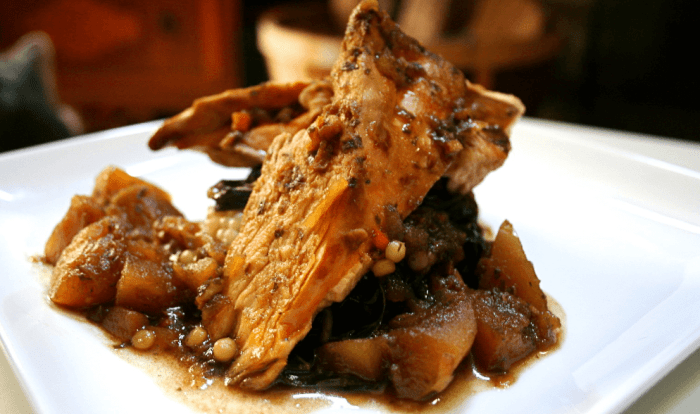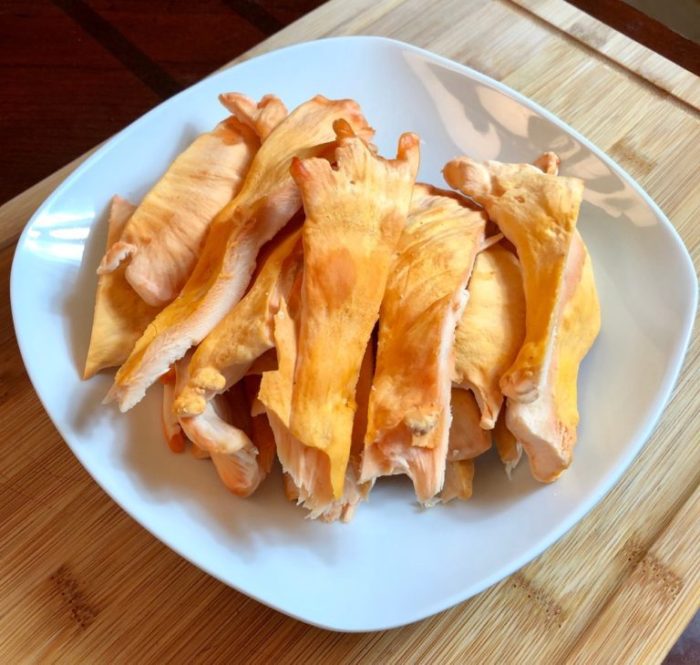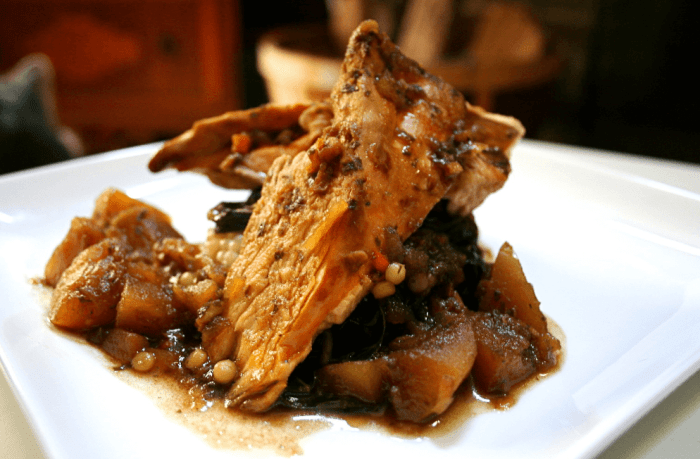
Chicken of the woods recipe – Welcome to the enchanting realm of Chicken of the Woods, a culinary delicacy that beckons mushroom enthusiasts and foodies alike. With its vibrant orange hue and meaty texture, this forest treasure offers a unique gastronomic experience that will tantalize your taste buds and ignite your culinary creativity.
Join us as we delve into the fascinating world of Chicken of the Woods, from identifying and harvesting this prized mushroom to exploring its culinary versatility and uncovering its potential health benefits. Let this guide be your trusted companion on your journey to master the art of cooking Chicken of the Woods.
Introduction to Chicken of the Woods

Chicken of the woods ( Laetiporus sulphureus) is a distinctive and highly prized edible mushroom known for its vibrant orange color and meaty texture. It is a polypore mushroom, meaning it has pores instead of gills on its underside.
Chicken of the woods is a versatile culinary ingredient that can be used in various dishes. It has a mild, slightly nutty flavor and a meaty texture that makes it an excellent substitute for chicken in many recipes. The mushroom can be sautéed, roasted, grilled, or fried and pairs well with a wide range of flavors and ingredients.
Nutritional Value
In addition to its culinary value, chicken of the woods is also a good source of nutrients. It is high in fiber, protein, and vitamins, including vitamin C, vitamin D, and potassium.
Habitat and Distribution
Chicken of the woods is found in forests worldwide, typically growing on dead or dying hardwood trees. It is most commonly found in the spring and fall, but it can also be found during other seasons depending on the climate.
Identification
Chicken of the woods is relatively easy to identify due to its distinctive appearance. It has a bright orange color, a meaty texture, and pores on its underside. However, it is important to note that there are other similar-looking mushrooms that can be poisonous, so it is crucial to be certain of your identification before consuming any wild mushrooms.
Identifying and Harvesting Chicken of the Woods

Chicken of the Woods is a distinctive mushroom that’s relatively easy to identify. Here’s a guide to help you find and harvest it responsibly:
Identification
Chicken of the Woods typically grows on the trunks of oak or other hardwood trees. It forms bright orange shelves that are often clustered together. The edges of the shelves are often wavy or lobed, and the undersides are covered in small, white pores.
Harvesting
The best time to harvest Chicken of the Woods is in the fall, after the first few frosts. Look for mushrooms that are firm and not too dry. To harvest, use a sharp knife to cut the mushroom from the tree.
Be sure to leave a small amount of the mushroom at the base to ensure future growth.
Sustainability
Chicken of the Woods is a popular mushroom, so it’s important to harvest it responsibly. Only take what you need, and always leave some behind for other foragers and wildlife. Additionally, avoid harvesting from areas that have been treated with pesticides or other chemicals.
Culinary Applications of Chicken of the Woods
Chicken of the Woods is a versatile culinary mushroom with a meaty texture and a slightly sweet, nutty flavor. It can be cooked in various ways, making it a popular choice for both home cooks and professional chefs.
The most common cooking methods for Chicken of the Woods include sautéing, roasting, and grilling. Sautéing is a quick and easy way to cook the mushroom, and it can be done in a pan with a little butter or oil.
If you’re venturing into the woods in search of Chicken of the Woods, be sure to consult this comprehensive guide . It provides detailed information on the mushroom’s appearance, habitat, and potential lookalikes, ensuring you’ll gather only the real deal.
Remember, foraging requires knowledge and caution, so always consult reliable sources before consuming any wild edibles.
Roasting is another popular method, which brings out the mushroom’s natural sweetness. Grilling is a great way to cook Chicken of the Woods if you want to give it a smoky flavor.
Recipes
There are many different recipes that showcase the versatility of Chicken of the Woods. Some popular recipes include:
- Sautéed Chicken of the Woods with Garlic and Thyme
- Roasted Chicken of the Woods with Rosemary and Lemon
- Grilled Chicken of the Woods with Balsamic Glaze
- Chicken of the Woods Soup
- Chicken of the Woods Risotto
These recipes are just a few examples of how Chicken of the Woods can be used in cooking. With its unique flavor and texture, this mushroom is a great addition to any meal.
Foraging enthusiasts, rejoice! Chicken of the Woods , a vibrant and delicious mushroom, is a must-try culinary adventure. Its distinct texture and earthy flavor make it a versatile ingredient, perfect for everything from stir-fries to soups. Whether you’re a seasoned forager or just starting out, this recipe will guide you through the process of identifying, preparing, and cooking this delectable treat.
Nutritional Benefits
Chicken of the Woods is a good source of several nutrients, including protein, fiber, and vitamins B and C. It is also low in calories and fat. The mushroom’s protein content makes it a good meat substitute for vegetarians and vegans.
Flavor Profile
Chicken of the Woods has a slightly sweet, nutty flavor that is similar to chicken. The mushroom’s texture is also similar to chicken, making it a popular choice for those looking for a meat substitute. The mushroom’s flavor is best when it is cooked fresh, but it can also be dried and stored for later use.
Health Benefits and Safety Considerations

Chicken of the Woods offers a range of potential health benefits, making it a nutritious addition to your diet.
One of its key benefits lies in its high fiber content. Fiber plays a crucial role in maintaining a healthy digestive system, promoting regularity and preventing constipation. Additionally, fiber helps control blood sugar levels, reducing the risk of developing type 2 diabetes.
Nutritional Value
- High in fiber:Aids digestion, regulates blood sugar levels.
- Rich in antioxidants:Protects cells from damage, reduces inflammation.
- Good source of protein:Essential for tissue repair, growth, and development.
- Contains vitamins and minerals:Supports overall health and well-being.
Chicken of the Woods is also a good source of antioxidants, which help protect cells from damage caused by free radicals. Free radicals are unstable molecules that can contribute to aging and the development of chronic diseases. Antioxidants neutralize these free radicals, reducing their harmful effects.
However, it’s important to note that Chicken of the Woods can cause allergic reactions in some individuals. Symptoms of an allergic reaction may include hives, swelling, and difficulty breathing. If you experience any adverse reactions after consuming Chicken of the Woods, seek medical attention immediately.
Safe Handling and Storage
- Proper storage:Store fresh Chicken of the Woods in the refrigerator for up to 5 days. It can also be frozen for longer storage.
- Cooking:Thoroughly cook Chicken of the Woods before consuming to destroy any potential harmful bacteria.
- Avoid raw consumption:Consuming raw Chicken of the Woods may lead to gastrointestinal issues.
By following these guidelines, you can enjoy the health benefits of Chicken of the Woods while ensuring its safe consumption.
Additional Resources and Tips
To further enhance your knowledge of Chicken of the Woods, here are some valuable resources and practical tips:
Websites and Online Forums
- MushroomExpert.com: A comprehensive website featuring detailed information on Chicken of the Woods, including identification, harvesting, and cooking.
- AmericanMushrooms.com: An online resource providing information on various mushroom species, including Chicken of the Woods, with a focus on culinary applications.
- Shroomery.org: An active online forum where mushroom enthusiasts share knowledge, experiences, and tips on identifying, harvesting, and cooking Chicken of the Woods.
Books, Chicken of the woods recipe
- Mushrooms of North Americaby Orson K. Miller Jr.: A comprehensive field guide covering over 600 mushroom species, including Chicken of the Woods, with detailed descriptions and illustrations.
- All That the Rain Promises and More: A Hip Pocket Guide to Western Mushroomsby David Arora: A compact and user-friendly guide to mushrooms found in the Western United States, including Chicken of the Woods.
- Chicken of the Woods: A Culinary and Medicinal Guideby Andy Hirsch: A specialized book dedicated to Chicken of the Woods, providing in-depth information on its culinary uses and potential health benefits.
Tips for Finding, Harvesting, and Cooking
- Look for Chicken of the Woods in deciduous forests, particularly around the base of oak, maple, or beech trees, from late summer to fall.
- When harvesting, use a sharp knife to cut the mushroom at the base, leaving the root intact to ensure future growth.
- Cook Chicken of the Woods thoroughlyto avoid potential digestive issues. It can be sautéed, grilled, roasted, or added to soups and stews.
Connecting with Local Mushroom Enthusiasts
Consider joining local mushroom clubs or attending mushroom foraging workshops to connect with experienced mushroom enthusiasts.
They can provide valuable guidance on identifying, harvesting, and cooking Chicken of the Woods safely and effectively.
Ultimate Conclusion: Chicken Of The Woods Recipe
As we bid farewell to the world of Chicken of the Woods, we hope this guide has ignited a newfound appreciation for this culinary gem. Whether you’re a seasoned mushroom hunter or a curious home cook, may your future culinary adventures be filled with the vibrant flavors and endless possibilities that Chicken of the Woods has to offer.
Remember, the forest holds countless secrets waiting to be discovered. Continue your exploration, connect with fellow mushroom enthusiasts, and let the wonders of nature inspire your culinary creations. Until next time, happy foraging and bon appétit!
Popular Questions
Q: What’s the best way to identify Chicken of the Woods?
A: Look for bright orange, shelf-like mushrooms with a velvety texture and white pores on the underside.
Q: Can I eat Chicken of the Woods raw?
A: No, it’s recommended to cook Chicken of the Woods before consuming it to enhance its flavor and digestibility.
Q: How long can I store Chicken of the Woods?
A: Fresh Chicken of the Woods can be stored in the refrigerator for up to 5 days. Cooked Chicken of the Woods can be stored in the freezer for several months.






